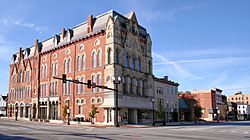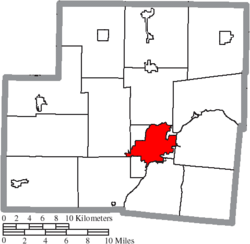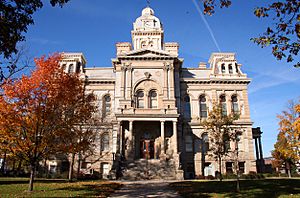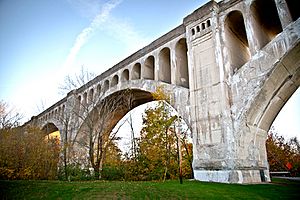Sidney, Ohio facts for kids
Quick facts for kids
Sidney, Ohio
|
|||
|---|---|---|---|

Sidney downtown, with the municipal courts in the Monumental Building.
|
|||
|
|||

Location of Sidney in Shelby County
|
|||
| Country | United States | ||
| State | Ohio | ||
| County | Shelby | ||
| Area | |||
| • Total | 12.10 sq mi (31.34 km2) | ||
| • Land | 11.97 sq mi (31.00 km2) | ||
| • Water | 0.13 sq mi (0.34 km2) | ||
| Elevation | 1,037 ft (316 m) | ||
| Population
(2020)
|
|||
| • Total | 20,589 | ||
| • Density | 1,720.05/sq mi (664.10/km2) | ||
| Time zone | UTC-5 (Eastern (EST)) | ||
| • Summer (DST) | UTC-4 (EDT) | ||
| ZIP codes |
45365, 45367
|
||
| Area code(s) | 937, 326 | ||
| FIPS code | 39-72424 | ||
| GNIS feature ID | 2395881 | ||
Sidney is a city in Ohio, United States. It is the main city of Shelby County. Sidney is about 36 miles (58 km) north of Dayton. It is also about 100 miles (160 km) south of Toledo.
In 2020, about 20,421 people lived in Sidney. The city is named after Philip Sidney, an English poet. Many of Sidney's elementary schools are named after famous writers. These include Ralph Waldo Emerson, Henry Wadsworth Longfellow, and John Greenleaf Whittier. Sidney won the All-America City Award in 1964. A documentary film called 45365 was made about the city in 2009.
Contents
History of Sidney

Sidney was named after Sir Philip Sidney, a famous poet. The city started on a 70-acre (280,000 m2) piece of land. This land was next to the Great Miami River. Charles Starrett gave this land to start a new town. This town would be the main city for Shelby County.
The area around Sidney was once a rich hunting ground. It was used by the Shawnee and Miami Indian nations. Over time, this fertile land became farms.
Canals and Railroads
The Miami-Erie Canal was built between 1825 and 1837. This canal connected Sidney to major trade centers in Ohio. It helped Sidney start trading with other places. The canal also brought many new settlers to the area. From the 1840s to 1913, canal boats carried products from Shelby County. They went to Cincinnati or Toledo.
Sidney was also connected by a part of the Miami and Erie Canal. This part was called the Sidney or Port Jefferson Feeder Branch. Before railroads, the canal was the main way to travel. Roads were often unpaved and hard to use. A small part of the canal still exists south of Water Street.
As canals became less important, railroads grew. East-west rail lines were built in 1851. North-south lines followed in 1856. These railroad lines still serve Sidney today.
Modern Transportation and Growth
In the 1950s, the Interstate Highway system helped Sidney grow. The city was named an "All-America City" in 1964. Today, Interstate 75 connects Sidney to Canada in the north. It also connects to Florida in the south. Sidney has four exits from Interstate 75. These exits help businesses and industries.
Parks and Famous People
Sidney has many parks and recreation areas. In the 1950s, the city planned to have a park near every home. This led to 14 neighborhood parks. There are also baseball, softball, and soccer fields. The city has a swimming pool. Tawawa Park is a 180-acre (0.73 km2) nature and picnic area.
Sidney is the hometown of Paul Lauterbur. He was a famous scientist and Nobel Prize winner. He helped create the MRI (Magnetic Resonance Imaging).
Several U.S. Presidents have visited Sidney. President Ronald Reagan visited in 1984. He rode on the same train President Franklin D. Roosevelt used in 1944. President George W. Bush visited in 2004. He ate at the Spot Restaurant. In 2012, Republican candidate Mitt Romney visited the Shelby County Fairgrounds.
Two other towns were named after Sidney. Sidney, Iowa got its name from this community. The town of Buckeye, Arizona was also named after Sidney. Malin M. Jackson, who built Arizona's Buckeye Canal, was from Sidney, Ohio.
Geography and Weather
Sidney covers a total area of about 12.15 square miles (31.47 km2). Most of this is land, about 12.02 square miles (31.13 km2). A small part, 0.13 square miles (0.34 km2), is water.
Climate in Sidney
Sidney has a climate with warm summers and cold winters.
| Climate data for Sidney, Ohio (1991–2020 normals, extremes 1978–present) | |||||||||||||
|---|---|---|---|---|---|---|---|---|---|---|---|---|---|
| Month | Jan | Feb | Mar | Apr | May | Jun | Jul | Aug | Sep | Oct | Nov | Dec | Year |
| Record high °F (°C) | 66 (19) |
74 (23) |
86 (30) |
88 (31) |
93 (34) |
102 (39) |
101 (38) |
100 (38) |
98 (37) |
97 (36) |
80 (27) |
71 (22) |
102 (39) |
| Mean maximum °F (°C) | 57.4 (14.1) |
61.5 (16.4) |
70.9 (21.6) |
80.1 (26.7) |
86.5 (30.3) |
91.8 (33.2) |
92.2 (33.4) |
91.2 (32.9) |
89.9 (32.2) |
82.3 (27.9) |
69.5 (20.8) |
60.1 (15.6) |
94.1 (34.5) |
| Mean daily maximum °F (°C) | 34.4 (1.3) |
38.5 (3.6) |
48.9 (9.4) |
62.3 (16.8) |
72.8 (22.7) |
81.2 (27.3) |
84.3 (29.1) |
83.0 (28.3) |
77.9 (25.5) |
65.2 (18.4) |
51.1 (10.6) |
39.6 (4.2) |
61.6 (16.4) |
| Daily mean °F (°C) | 26.2 (−3.2) |
29.3 (−1.5) |
38.5 (3.6) |
50.0 (10.0) |
61.0 (16.1) |
70.1 (21.2) |
73.2 (22.9) |
71.4 (21.9) |
65.2 (18.4) |
53.3 (11.8) |
41.3 (5.2) |
31.7 (−0.2) |
50.9 (10.5) |
| Mean daily minimum °F (°C) | 17.9 (−7.8) |
20.1 (−6.6) |
28.0 (−2.2) |
37.8 (3.2) |
49.1 (9.5) |
58.9 (14.9) |
62.1 (16.7) |
59.8 (15.4) |
52.5 (11.4) |
41.5 (5.3) |
31.5 (−0.3) |
23.9 (−4.5) |
40.3 (4.6) |
| Mean minimum °F (°C) | −5.2 (−20.7) |
1.8 (−16.8) |
10.6 (−11.9) |
23.5 (−4.7) |
34.4 (1.3) |
45.9 (7.7) |
51.6 (10.9) |
49.9 (9.9) |
39.6 (4.2) |
27.9 (−2.3) |
17.2 (−8.2) |
5.6 (−14.7) |
−8.4 (−22.4) |
| Record low °F (°C) | −31 (−35) |
−17 (−27) |
−9 (−23) |
13 (−11) |
24 (−4) |
36 (2) |
44 (7) |
40 (4) |
30 (−1) |
19 (−7) |
2 (−17) |
−22 (−30) |
−31 (−35) |
| Average precipitation inches (mm) | 2.89 (73) |
2.31 (59) |
3.17 (81) |
4.08 (104) |
4.08 (104) |
4.70 (119) |
4.57 (116) |
3.76 (96) |
3.11 (79) |
2.89 (73) |
3.17 (81) |
2.92 (74) |
41.65 (1,058) |
| Average precipitation days (≥ 0.01 in) | 11.3 | 10.9 | 12.0 | 12.1 | 13.2 | 12.0 | 11.3 | 9.1 | 8.1 | 9.1 | 9.9 | 11.5 | 130.5 |
| Source: NOAA | |||||||||||||
Population of Sidney
| Historical population | |||
|---|---|---|---|
| Census | Pop. | %± | |
| 1830 | 240 | — | |
| 1840 | 713 | 197.1% | |
| 1850 | 1,302 | 82.6% | |
| 1860 | 2,055 | 57.8% | |
| 1870 | 2,808 | 36.6% | |
| 1880 | 3,823 | 36.1% | |
| 1890 | 4,850 | 26.9% | |
| 1900 | 5,688 | 17.3% | |
| 1910 | 6,607 | 16.2% | |
| 1920 | 8,590 | 30.0% | |
| 1930 | 9,301 | 8.3% | |
| 1940 | 9,790 | 5.3% | |
| 1950 | 11,491 | 17.4% | |
| 1960 | 14,663 | 27.6% | |
| 1970 | 16,332 | 11.4% | |
| 1980 | 17,658 | 8.1% | |
| 1990 | 18,710 | 6.0% | |
| 2000 | 20,211 | 8.0% | |
| 2010 | 21,229 | 5.0% | |
| 2020 | 20,589 | −3.0% | |
| 2021 (est.) | 20,421 | −3.8% | |
| Sources: | |||
In 2010, there were 21,229 people living in Sidney. There were 8,344 households. About 5,577 families lived in the city. The city had about 1,766 people per square mile.
Most people in Sidney were White (90.3%). About 3.7% were African American. About 1.6% were Asian. People of Hispanic or Latino background made up 2.2% of the population.
About 35.4% of households had children under 18. The average household had 2.51 people. The average family had 3.01 people. The average age in Sidney was 36.1 years.
Economy and Jobs
Sidney is home to many company headquarters. It also has branch offices for other companies. Many businesses started in Sidney and are still run by local people. The city has many different types of jobs. These include jobs in manufacturing, especially in the car industry, and service jobs.
The biggest employer in Sidney is Emerson Climate Technologies. It has over 1,700 employees. The Honda of America engine plant in Anna is 7 miles north of Sidney. It is the largest employer in Shelby County, with 3,200 employees.
Amos Press in Sidney publishes Coin World and Linn's Stamp News. These are popular magazines for collectors. The area also has many farms. They grow grains and raise livestock and dairy animals.
In 2022, SEMCORP announced plans to open a new factory in Sidney. This factory will create about 1,200 jobs. It will make separator film, which is a key part of batteries for electric cars.
Arts and Fun Activities
Sidney, Ohio, has a drive-in movie theater called the Auto-Vue. It is open from May to September. In the fall, there is a large corn maze at Vandermark's Farm. The area also has a driving range for golfers. There is an 18-hole miniature golf course and a zip line.
The Historic Sidney Theatre was built in 1921. It is in downtown Sidney. It has been updated with a new sound system. You can see concerts, movies, and live shows there.
The Gateway Arts Council is a non-profit arts group. It is located downtown. It offers many arts, entertainment, and cultural events. These events are for all ages.
Sidney Alive is a group that helps improve downtown Sidney. They organize a farmers' market during the growing season. They also host community events. These include an Easter egg hunt, Kids Around the Square, and the Winter Wonderland Parade. They also have a Chocolate Walk, horse and carriage rides, and mystery dinners. They work with local businesses to make downtown Sidney a fun place.
The Shelby County Historical Society has a museum. It is called the William A. Ross Junior Historical Society. It is at 201 N. Main Street. You can see historical items from Sidney and Shelby County there. It is open Monday to Friday, 1-5 pm, and Saturday, 9 am – noon.
For outdoor lovers, there are state parks nearby. These include Lake Loramie, Kiser Lake, Indian Lake, and Grand Lake St Marys. They are an easy drive from Sidney. You can go camping, boating, hunting, and fishing in these areas.
Sidney's Architecture
Sidney has several interesting buildings. The courthouse was built in 1881 in the Second Empire style. The Monumental Building was built in 1877. It is in the Gothic revival style. It honors soldiers from the Civil War.
The People's Federal Savings and Loan Association building was built in 1918. It was designed by the famous architect Louis Sullivan. This building is a National Historic Landmark.
The Big Four Bridge is a local landmark. It has carried trains since 1924. CSX Transportation uses this bridge and rail line today. It is part of the "NYC" division of Conrail. This company is connected to the New York Central Railroad. CSX also runs the north-south rail line. This line was once known as the Baltimore and Ohio Railroad.
Graceland Cemetery has many large monuments and statues. These include concrete angels.
Education in Sidney
The Sidney City School District runs four elementary schools. It also has one middle school and Sidney High School. There is also Lehman Catholic High School in the city. It is a private school connected to the Roman Catholic Archdiocese of Cincinnati.
Sidney has a public library called Amos Memorial Library. It is part of the Shelby County Libraries system.
Media and News
- The Sidney Daily News is a newspaper published almost every day.
- WMVR-FM broadcasts music on 105.5 FM.
- Scores Broadcast is a website that offers live high school sports coverage.
- KLOVE 94.1 FM (translator W231AZ) and WHJM 88.7 FM "Radio Maria" are radio stations.
- The Sidney Ohio News Blog is a newer online news source.
Transportation Hub
Air Travel
Sidney has its own airport, the Sidney Municipal Airport. For bigger flights, Dayton International Airport is 35 miles (56 km) south. Port Columbus is 106 miles (171 km) east.
Railroads in Sidney
Sidney has two main railroad lines. Both were built in the 1850s.
Until the 1960s, people could take a train called the Knickerbocker Limited from Sidney. It went all the way to Grand Central Terminal in New York City. This east-west line was first called the Bellefontaine and Indiana Railroad. It connected Ohio and Indiana. Later, it became part of larger railroad companies. Today, CSX Transportation uses this line.
In the 1950s, passengers could take a train south from Sidney. It went to Cincinnati and even New Orleans. This north-south line was first the Dayton and Michigan Railroad. Later, it became part of the Baltimore and Ohio Railroad. Today, CSX Transportation also uses this line. Passenger services on this line have been reduced.
Road System
The Dixie Highway, also known as US 25, used to run through downtown Sidney. It connected Sidney to Toledo and Detroit in the north. It also connected to Dayton and Cincinnati in the south.
Interstate 75 was finished in the early 1960s. It is west of Sidney. It took over most of the traffic from the Dixie Highway. Interstate 75 has four exits that lead directly into Sidney. These are exit 90 (Fair Road), exit 92 (State Route 47), exit 93 (State Route 29), and exit 94 (County Road 25A).
Notable People from Sidney
Many interesting people have come from Sidney, Ohio:
- John Adams, a former member of the Ohio House of Representatives.
- Craig Clemons, a retired NFL football player.
- Warren Davidson, a member of the U.S. House of Representatives.
- George Clyde Fisher, a museum curator.
- Dick Flanagan, an NFL football player.
- Warren A. Haggott, a congressman from Colorado.
- Thomas Hazzard, a football player, coach, minister, and missionary.
- Richard Hodges, a politician.
- John Foley Horr, a Civil War captain.
- Marie Agnes H. Hyde, an artist.
- Brandon Knupp, a stock car racing driver.
- Paul Lauterbur, a chemist and Nobel Prize winner.
- Dale Locker, a former member of the Ohio House of Representatives.
- Joey Long, a former Major League Baseball pitcher.
- Louis Mackey, a philosopher and writer.
- George Alexander Marshall, a member of the U.S. House of Representatives.
- Bruce Moon, an art therapist and psychologist.
- James Murray, the 7th Ohio Attorney General.
- Richard Pefferle, a set decorator for movies and TV.
- J. Edward Russell, a member of the U.S. House of Representatives.
- Rick Stockstill, a head football coach.
Images for kids
See also
 In Spanish: Sidney (Ohio) para niños
In Spanish: Sidney (Ohio) para niños






